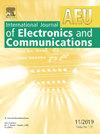An Ultra-Low Noise, Power-Efficient AFE based on Current-Reuse and splitting techniques for Multibiosignal acquisition
IF 3.2
3区 计算机科学
Q2 ENGINEERING, ELECTRICAL & ELECTRONIC
Aeu-International Journal of Electronics and Communications
Pub Date : 2025-09-23
DOI:10.1016/j.aeue.2025.156051
引用次数: 0
Abstract
This paper presents an ultra-low-power and low-noise Bio-analog front-end (BioAFE) with a tunable frequency response for bio signals acquisition such as EEG, ECG, and EMG. The proposed BioAFE consists of only two stages. In the first stage, the proposed operational transconductance amplifier (OTA) successfully employs current reuse and gain boosting techniques to enhance power efficiency and gain. In the second stage of the proposed BioAFE, the band-pass filter (BPF) and variable gain amplifier (VGA) are integrated to optimize energy consumption and reduce chip area. A current-splitting technique is proposed in this stage, which adjusts the high cut-off frequency by modifying the OTA’s transconductance without additional power consumption. Consequently, the proposed BioAFE can provide a gain of 65 dB, 54 dB and 44 dB with bandwidth of (0.4–100 Hz), (0.5–500 Hz) and (12–1500 Hz) for EEG, ECG and EMG signals, respectively. The proposed BioAFE, which employs chopper stabilization and positive feedback loop (PFL) techniques in its first stage, has successfully improved the input-referred noise and input impedance to 309 nVrms and 9 GΩ, respectively. The proposed BioAFE operates with a 0.8 V power supply and consumes a total power of 144 nW. The proposed structure has been designed and evaluated using Cadence software on TSMC 65 nm CMOS technology, occupying a chip area of 0.0645 mm2.
一种基于电流复用和分离技术的超低噪声、节能的多生物信号采集AFE
本文介绍了一种超低功耗、低噪声的生物模拟前端(BioAFE),具有可调的频率响应,用于生物信号采集,如脑电图、心电图和肌电图。拟议的BioAFE仅包括两个阶段。在第一阶段,所提出的运算跨导放大器(OTA)成功地采用电流复用和增益提升技术来提高功率效率和增益。在提出的BioAFE的第二阶段,集成了带通滤波器(BPF)和可变增益放大器(VGA),以优化能耗并减小芯片面积。在此阶段提出了一种电流分裂技术,该技术通过改变OTA的跨导来调整高截止频率,而无需额外的功耗。因此,所提出的BioAFE可以提供65 dB、54 dB和44 dB的增益,带宽分别为(0.4-100 Hz)、(0.5-500 Hz)和(12-1500 Hz),用于EEG、ECG和EMG信号。所提出的BioAFE在第一阶段采用斩波稳定和正反馈回路(PFL)技术,成功地将输入参考噪声和输入阻抗分别提高到309 nVrms和9 GΩ。提出的BioAFE在0.8 V电源下工作,总功耗为144 nW。采用Cadence软件在台积电65nm CMOS技术上设计并评估了该结构,其芯片面积为0.0645 mm2。
本文章由计算机程序翻译,如有差异,请以英文原文为准。
求助全文
约1分钟内获得全文
求助全文
来源期刊
CiteScore
6.90
自引率
18.80%
发文量
292
审稿时长
4.9 months
期刊介绍:
AEÜ is an international scientific journal which publishes both original works and invited tutorials. The journal''s scope covers all aspects of theory and design of circuits, systems and devices for electronics, signal processing, and communication, including:
signal and system theory, digital signal processing
network theory and circuit design
information theory, communication theory and techniques, modulation, source and channel coding
switching theory and techniques, communication protocols
optical communications
microwave theory and techniques, radar, sonar
antennas, wave propagation
AEÜ publishes full papers and letters with very short turn around time but a high standard review process. Review cycles are typically finished within twelve weeks by application of modern electronic communication facilities.

 求助内容:
求助内容: 应助结果提醒方式:
应助结果提醒方式:


